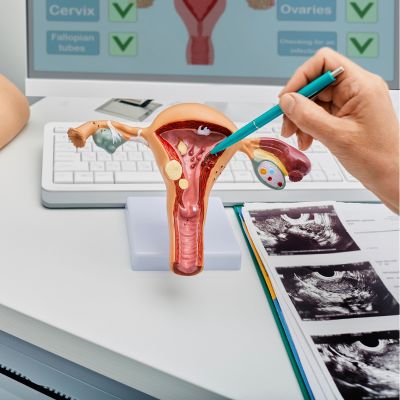Gynaecology treatment

Hysterectomy : –
Hysterectomy may be of four types :
• Total hysterectomy: The whole uterus along with the cervix, is removed.
• Total hysterectomy with bilateral salpingo-oophorectomy: Includes removal of the uterus, cervix, salpingectomy (removal of fallopian tubes) and the oophorectomy (removal of ovaries.
• Subtotal or partial hysterectomy: Leaving the cervix in place, only the upper part of the uterus is removed.
• Radical hysterectomy: Along with the uterus, parametrium and nearby lymph nodes also be removed. Generally, recommended for diagnosed or suspected cases of cancer .
The gynaecologist will decide the best approach to conduct hysterectomy, depending upon the nature of the case and the medical condition of the patient. Hysterectomy can be done in the following different routes:
Vaginal Hysterectomy: The uterus is removed through the vagina and there is no abdominal inscision or scar.Most commonly performed surgery for uterine prolapse.
Vaginal hysterectomy generally causes fewer complications than abdominal or laparoscopic hysterectomy. It has a faster return to normal activities. It is recommended as the first choice for hysterectomy when possible.
However all uteri cannot be removed vaginally and we have to opt for abdominal route.These can be conducted in 2 ways:
Total Abdominal hysterectomy: An incision is made in the lower abdomen to view the pelvic organs and remove the uterus. Abdominal hysterectomy is performed in presence of complications like adhesions or large uterus where vaginal hysterectomy is not possible.
Laparoscopic surgery or key hole surgery: Few small incisions are made in the abdomen through which the laparoscope and other side ports are inserted to let the surgeon view the pelvic organs and remove the uterus.
Commonest Indications for Hysterectomy :
• Uterine fibroids (this is the most common reason for hysterectomy)
• Adenomyosis
• uterine prolapse
• Abnormal uterine bleeding
• Gynecologic precancers and cancerous lesions.
Period Problems : –
A woman’s period usually occurs every 28 days, but normal menstrual cycles can range from 21 days to 35 days.
Regular periods are a sign that your body is working normally. You should have regular periods unless you are pregnant, breastfeeding, postmenopausal, or have a medical condition that causes your periods to stop.
Irregular, painful, or heavy bleeding affects up to 14% of women of childbearing age. Various Period Problems that can occur are:
Amenorrhea is a condition in which a woman’s periods have stopped completely.
Oligomenorrhea refers to periods that occur infrequently.
Polymenorrhea Periods occur at frequency of lesser than 20 days
Dysmenorrhea refers to painful periods and severe menstrual cramps. Some discomfort during the cycle is normal for most women.
Menstrual irregularities like a heavier menstrual flow; a period that lasts longer than seven days; or bleeding or spotting between periods, after sex, or after menopause.
Causes of abnormal menstrual bleeding :
The cause of heavy menstrual bleeding in adolescents cannot always be determined, but several factors have been linked to the condition.
1) Hormonal imbalance
Hormone imbalances between estrogen and progesterone can cause abnormal menstrual bleeding. Commenest causes of hormonal imbalances are :
Polycystic ovarian syndrome
Obesity
Thyroid issues such as hypothyroidism
2) Bleeding disorders such as Von Willebrand disease,Platelet disorders, such as low platelets or poorly functioning platelets
3) Infectionssuch as Sexually transmitted infections,Pelvic infections
4) Structural problems: These may include:
Polyps — small, benign (non-cancerous) growths that form on the lining of the uterus can cause heavy or prolonged menstruation.
Uterine fibroids — benign tumors that form in the uterus can also cause prolonged or heavy menstrual bleeding.
Cancer— malignant (cancerous) growths in the uterus or cervix can cause heavy or prolonged bleeding specially in perimenopausal age.
